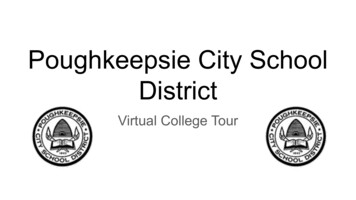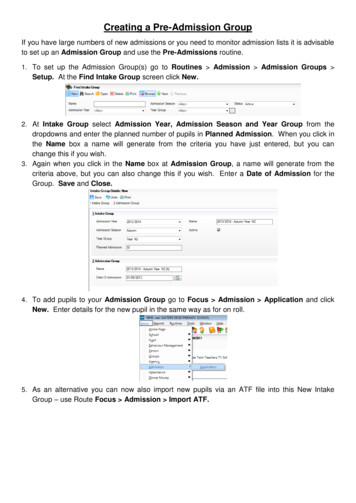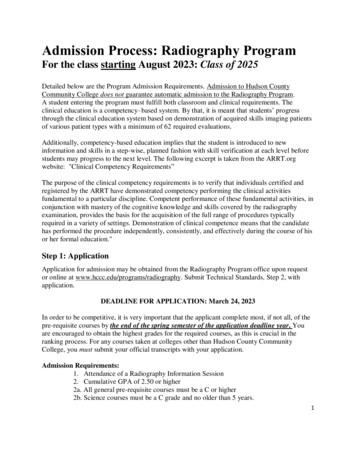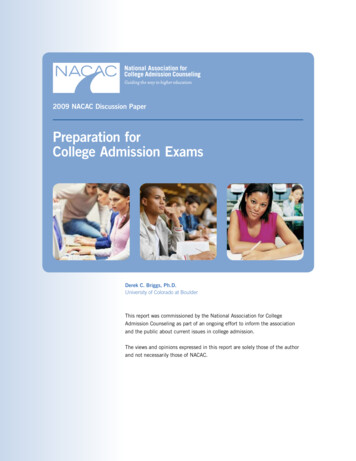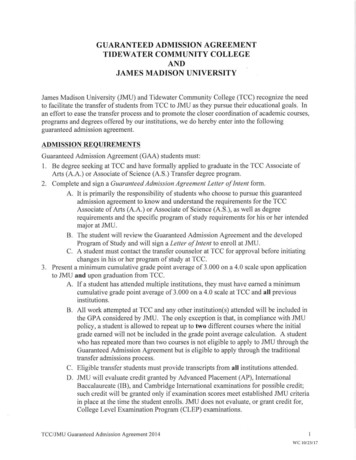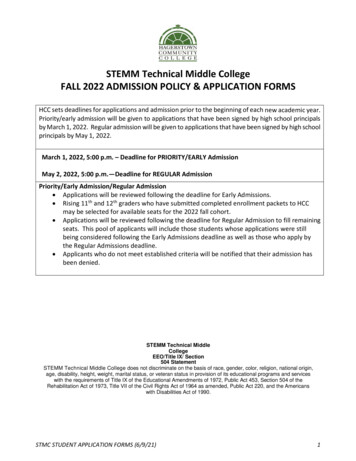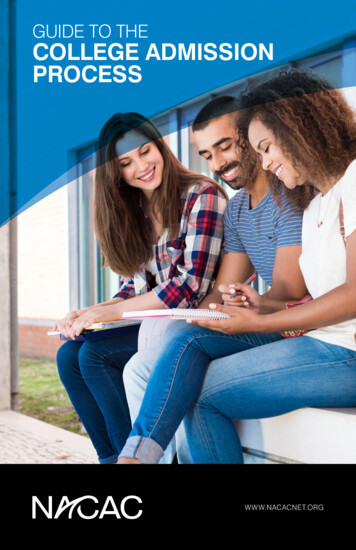
Transcription
GUIDE TO THECOLLEGE ADMISSIONPROCESSWWW.NACACNET.ORG
Guide to the College Admission ProcessPublished in 1979.Revised in 1984, 1989, 1993, 1994, 1998, 2000, 2002, 2003,2007, 2009, 2011, and 2015.Copyright 2015, NACAC.Additional copies of Guide to the College Admission Process areavailable for 13 each (includes shipping and handling). Singlecopies can be downloaded for no cost at www.nacacnet.org.Send orders to:National Association for College Admission Counseling1050 N. Highland Street, Suite 400Arlington, VA 22201www.nacacnet.org703/836-2222Bulk quantities available:Member (m) and nonmember (nm) rates.Dollar amount is for each copy.1–10 @ 13m/ 16nm; 11–25 @ 11m/ 14nm;26–50 @ 9m/ 12nm; 51–100 @ 7m/ 10nm;100 @ 5m/ 8nmAdditional shipping rates will apply to overseas orders.Virginia residents must add 5 percent sales tax.Call for additional quantities/rates.Please make all checks payable to National Associationfor College Admission Counseling.
Table of ContentsChapter 1: A Look at the College Admission Process. 3Chapter 2: Get Set for Action—Your Junior Year. 7Chapter 3: Terms You Need to Know. 13Chapter 4: National College Fairs . 20Chapter 5: College Publications. 23Chapter 6: The Parts of an Admission Folder. 26Chapter 7: Your Senior Year—Apply Yourself. 30Chapter 8: Financial Aid for College. 35Chapter 9: For Families—Some Advice and Encouragement. 46Chapter 10: Plan B—Wait Lists and Rejection Letters. 48Chapter 11: Ease into the Transition. 52Chapter 12: Transferring Colleges. 55Chapter 13: Alternative Options . 59Chapter 14: Applying to US Colleges and Universities as anInternational Student. 63Appendix A: College Admission Application Checklist . 68Appendix B: The Prep for College Calendar. 70NACAC GUIDE TO THE COLLEGE ADMISSION PROCESS1
About the AuthorThe Guide to the College Admission Process is based on theoriginal guide by Steven C. Munger, former dean and collegecounselor at Bridgton Academy (ME). Mr. Munger has servedas president of the New England Association for CollegeAdmission Counseling and was the 1989 recipient of NACAC’sJohn B. Muir Editor’s Award. Mr. Munger is the co-author ofSelecting the Right College.AcknowledgementsNACAC would like to thank Jennifer Gross, author ofNACAC’s Steps to College series, for the use of portionsof those articles.2NACAC GUIDE TO THE COLLEGE ADMISSION PROCESS
1Chapter 1A Look at the CollegeAdmission ProcessYou are entering a very exciting period of your life. Perhaps you alreadyhave some firm ideas of where you would like to go to college. Maybeyou’ve even started to eliminate some possibilities. But, before you go further,this point must be made: Whatever your financial resources are, don’t allowthe cost of a college education to cut short your educational pursuits.There is substantial financial aid available for you and your family as you worktogether to meet college costs. To prove the point, we’ve dedicated an entirechapter to the subject of financing college, but that comes later.The transition from high school to college is filled with challenge, opportunityand decisions. The process of selecting, applying to and gaining admission tocollege can be difficult and confusing, but it has its rewards—if you work at it.Remember that the college admission process has a beginning, a middle andan end. Approaching college selection with this perspective in mind will leadto smooth transitions and sound decision-making.Because the process of selecting a college is very personal,it begins with self-reflection.Consider your goals, strengths, weaknesses, and reasons for going to college.Then, think about the many criteria you will use in choosing which collegesto explore.When you are thinking about yourself, be realistic.NACAC GUIDE TO THE COLLEGE ADMISSION PROCESS3
CHAPTER 1Dream, but keep one foot on the ground. Consult your parents and othersabout your future, but keep in mind that it is your future and that you musteventually make the decisions. You don’t have to find the answers to all ofyour questions, but you do need to consider questions about the future as youapproach the process of applying for admission to college.Your school counselor knows the various steps in the admission process andcan help you establish and keep an admission schedule. Just as important,your counselor can help you better understand yourself, your interests andyour needs.Make a list of what’s important to you and discuss it with your counselor.Use these prompts to get started: Why do I want to go college? What are my long-term goals? Am I interested in a liberal arts institution, or do I want to specialize ina career or major, such as business, engineering or nursing? Do I want atwo- or four-year institution? Do I want to stay near home, or am I prepared to visit my family only afew times each year? Am I interested in a certain area? Urban, small townor rural? Do I want to attend a small or large institution? Am I interested in adiverse student body? Coed or single-sex school? Have my grades been good enough to be considered by a very selectiveschool? What is my current class rank? Do I want a demanding academicenvironment? Do I plan to go to graduate school? Am I comfortablewith a curriculum that offers a great deal of independent study? Do myacademic interests require specialized facilities? Do I prefer on- or off-campus housing? Am I interested in fraternities orsororities? How important are intramural or intercollegiate athletics? Do Iwant a campus that regularly offers cultural events? How important will costs be in my final choice? What kind of financialassistance will I need? Are opportunities for part-time jobs important?What qualifications do I have for scholarships? Is there a special area of study that I’m particularly interested in, or do Iwant to pursue more general studies?4NACAC GUIDE TO THE COLLEGE ADMISSION PROCESS
CHAPTER 1Feel free to add and consider your own questions. Remember that you arebeginning the process of selecting your college. Don’t be reluctant to expressyour true feelings. Perhaps you’re unsure about some of the questions andanswers. Maybe you think you’re not ready to go away to school. It’s OK to beapprehensive. Not everyone knows exactly what he or she wants at this time.Throughout the process, one of your best resources is yourschool counselor.Discuss your ideal college in relation to your academic profile (grades, classrank, test scores, activities, and course levels). Using the information fromthese conversations, you and your counselor can begin to develop a list ofcolleges that meet your criteria.Work with your counselor to determine the factors—from location toacademic offerings—that matter most to you. Create a college list that reflectsthose elements.The next step in the process is to obtain information about the colleges onyour list. Many college websites include forms on their admission pages thatyou can complete to connect with a college representative. Or you can simplyemail the college or university and request more information. Don’t forget togive them your name, address and year of graduation from high school. Youdon’t need to send a lengthy message at this point in the process.Most high school guidance offices are equipped with information you can useto acquire lots of good information very quickly. In general, the material sentto you by a college or posted on its website will be up-to-date. Informationobtained from any general source, like a college guide or handbook, may be alittle out-of-date.While you are looking for colleges, the colleges are also looking for you.Colleges obtain lists of students from the Student Search Service of theCollege Board and from the Educational Opportunity Service of ACT and usethem to initiate contact with students. When registering for the ACT or SATyou may indicate whether you want to share your name with these services. Ifyou participate, count on receiving literature from many colleges.As literature from colleges arrives at your home, you should read the materialthoroughly. You may find it helpful to summarize the information on yourcomputer or even in a notebook. The key to sorting out college options at thispoint is being organized. (See Chapter 5 for details on using literature.)NACAC GUIDE TO THE COLLEGE ADMISSION PROCESS5
CHAPTER 1Take advantage of college visits to your school. Admission representativesfrom the colleges that you’re interested in might be stopping by. Talk to yourcounselor and watch for lists of upcoming college visits. When you sit downwith a representative, remember to ask questions. Don’t take the meetinglightly—the college rep you meet at school may be a member of the admissioncommittee that reviews your folder.As your junior year of high school concludes, you may have already madesome decisions about the colleges on your initial list. You can eliminate thosethat don’t fit your needs and look further into the schools that appeal to you.At this stage of the process, gathering good information is the goal.College visits are the best way of assessing schools.Try to visit some of the campuses that interest you during the summer afteryour junior year. As the summer progresses, use those visits, along with whatyou have read, to narrow your list of colleges.Be aware of deadlines and submit applications well in advance of those dates.If you are applying for financial aid, you should note that some financial aiddeadlines differ from admission deadlines.The stage is set. Depending on the timetables and policies of the colleges,applicants will be notified of admission decisions at various times during theirsenior year.Self-assessment, evaluation, patience, persistence, organization, and above all,good humor and perspective are the elements of a happy transition from highschool to college.6NACAC GUIDE TO THE COLLEGE ADMISSION PROCESS
2Chapter 2Get Set For Action—Your Junior YearDuring your junior year, most of the college admission process centersaround preparation for choosing colleges.You are in control; you are doing the research and selecting the colleges thatmeet your needs. As a senior, once you narrow the list of choices to thoseinstitutions that really appeal to you and submit your applications, you handcontrol of the process to the colleges.For now, though, it’s all up to you. It’s time to get started. Consult the Prepfor College Calendar and develop a plan. (See Appendix B.)Take the PSAT in October; schedule ACTs and SATs for later in the year.Check diploma requirements to be certain you’re in the right courses. Buckledown to be sure that your grades are good as you approach your last year inhigh school.Academic grades are very important in the junior year. A poor performance inthe junior year sets the stage for an uphill battle in the first half of the senioryear as you attempt to make up for past mistakes. In general, colleges prefer asteady rate of performance over inconsistent spurts of good and bad; but if theentire record cannot consistently be at the best possible level of performance,the next best record shows steady improvement from year to year.You’ll also need to spend time weighing postsecondary plans. Much of junioryear will be devoted to gathering information about colleges, admissionprocedures and yourself.NACAC GUIDE TO THE COLLEGE ADMISSION PROCESS7
CHAPTER 2Good decisions are made by gathering good information andby being organized.Yes, your plate is full, but remember that your family, teachers and counselorsare all available to help. Start with your family. They have much to offer inadvice and guidance. The process of selecting and gaining admission is clearlyyours, but the opinions of your parents and others are important. The basisof a good relationship with your family during the college admission processcenters on mutual respect.Ask for advice, listen to what they say—and ask that they listen to youin return.You can also turn to professional assistance. Your high school counselor can provide you with reference materials,information and advice. They can help you determine which courses youshould take to achieve the goals you have established, and which testsyou should take. In most cases, the guidance office is also responsible forsending your transcript with courses, grades, grade point average (GPA),and class rank to colleges. Consult your counselor early in the process,and keep reporting on your progress. An independent counselor can devote a lot of time and attention toyour college quest, which helps explain the growing popularity of suchprofessionals among students and their families. If you decide to consultan independent counselor, take the time necessary to research thatperson’s credentials. Talk to former clients and college admission officials.Ask in advance what the fee will be—usually ranging from 1,000to 4,000. If the price is particularly low, there may be reason to besuspicious; however, there are programs that offer independent counselingto low-income students for little or no cost. Be aware that independentcounselors are paid to offer advice and help only. They should not try tofill out your application, write your essays or promote one institution overanother.Check online, or at your local bookstore or library, for more resources to helpyou pinpoint the colleges best-suited to your needs.Once you’ve determined the colleges of interest to you, dig deeper. Mostcollege websites have forms on their admission pages to request printedmaterials.8NACAC GUIDE TO THE COLLEGE ADMISSION PROCESS
CHAPTER 2Using online and print materials, make note of: deadlines for applications, test scores and interviews likes and dislikes, pros and cons based on the criteria youdetermined earlier special programs and requirements. (For example, is there a languagerequirement for the degree? Does that appeal to you, or is it somethingyou’d want to avoid?)Don’t feel obligated to read the material all at once and form an opinionimmediately—that’s why you’re taking notes. Resist the temptation to formopinions based only on photographs.Take your time. Read and think about each school as carefully as possible.When you have read materials from several colleges, you can then review yournotes and form a list of your common likes and dislikes.Your list of colleges should be taking shape as you apply your criteriaand make decisions. Don’t be afraid to eliminate colleges once you havedetermined that they don’t fit your needs.It’s important to keep college literature and maintain completeand accurate records.Develop a separate file on each school. Save the materials they’ve sent you andthe research you’ve done on them. Also, keep copies of everything you submitin the college application process.A calendar can help you keep track of important deadlines and dates,including: meetings with your counselor college fairs visits to your high school by college representatives college application deadlines (they vary from school to school) deadlines to sign up for tests test dates deadlines for your teachers to submit recommendations college interviews and visits.In addition, use your calendar to record the dates you submit materials tocollege admission offices. For help in mapping out your schedule, refer to thePrep for College Calendar in Appendix B.NACAC GUIDE TO THE COLLEGE ADMISSION PROCESS9
CHAPTER 2The College Visit and the InterviewVisiting a college campus is the best way to determine whether you want tospend several years there. Plan campus visits at the end of your junior year,during summer months or early in your senior year.Make an appointment for a visit by emailing or calling the admission office.When you visit a campus: Take a tour and check out facilities, including dormitories. Talk to students, a very useful source of information about a college (butremember that students’ personal opinions must be considered with care). Visit a class, if possible, and talk with a faculty member. Have a meal on campus. Visit a coffee shop, student center or pub to meet students. Read the campus newspaper to find out about campus issues; check thebulletin boards in the student union or cafeteria. Ask questions. Don’t be bashful!If you visit the campus of a college that offers personal interviews, be sure toset up an appointment.When you have your interview: Be prompt. Be neat; appropriate dress is an easy way to make a good impression. Be well-prepared; read the college’s catalog or visit its website priorto your interview and prepare questions based on what you read.Examples include:10nWhat percentage of students come back after freshman year?nCould you tell me some details about a program/major?nWhat makes a program/major a good one?nWhat social options are available?nWhat campus issues are students talking about this year?nHow involved are students in extracurricular activities? Do moststudents stay on campus during the weekends?NACAC GUIDE TO THE COLLEGE ADMISSION PROCESS
CHAPTER 2 Before the interview, think about how you’d answer the followingquestions:nWhat are your goals?nHow does this college fit in with your interests and talents?nWhat majors are you interested in, and why?nWhat are you passionate about?nWhy do you want to attend college? Why this college?nWhat extracurricular activities are important to you?nWhat academic or intellectual topics interest you?nWhat types of books do you enjoy reading? Answer questions to the best of your knowledge and ability. Don’t beafraid to admit that you don’t know something. Be ready to volunteer information. Know your test scores, class rank,latest grades, and current course load. Be yourself; don’t pretend to be something or someone you are not. Don’t be concerned if your interviewer is someone other than the deanor director of admission. If the interview is an important part of theadmission process at a college, all interviews given on campus haveequal weight. All interviewers are trained and prepared to represent theinstitution. An interview with a senior staff member is not essential. Above all, relax. Interviews are meant to be informative to both parties.Try to get as much out of an interview as you provide for it. When you get home, consider writing a thank-you note to yourinterviewer and tour guide.Group Information SessionsMany colleges that have great numbers of prospective students visiting theircampuses each year have eliminated the personal, on-campus interview fromtheir admission process.Instead, these colleges have instituted group information sessions to provideaccurate information to several students and parents at the same time.Combined with campus tours, group information sessions are excellentresources to use in researching and evaluating colleges.NACAC GUIDE TO THE COLLEGE ADMISSION PROCESS11
CHAPTER 2Don’t be bashful about asking the questions you want answered in groupsessions. If a college does not offer personal interviews, you need not beconcerned about trying to arrange one. Rather, if you have somethingpersonal to convey to an admission officer, use the application essay or write aletter to accompany your application.Alumni InterviewsSome colleges have developed elaborate alumni networks throughout thenation and use members of these groups to interview applicants. Severalcolleges even require alumni interviews, regardless of whether or not you havehad a campus visit or interview. If you are unable to have an interview oncampus with an admission officer, and if you feel that you have something togain from an interview, check online or email the college about the possibilityof scheduling an alumni interview in your area.A Last Word about the Campus VisitIf you visit a college, but don’t participate in a group information session orinterview, it may be wise to let the admission office know that you saw thecampus.Taking the time to see a college is one indication of your interest. Conversely,if you live only a few hours from a campus and don’t visit, it may be assumedthat you are not very interested in that institution.12NACAC GUIDE TO THE COLLEGE ADMISSION PROCESS
3Chapter 3Terms You Need toKnowThe following list of definitions and explanations should serve as a handyreference of the many terms and often-used abbreviations in the collegeadmission process.I. Tests and TestingColleges vary in their emphasis on standardized tests, but surveys regularlyreveal that admission officers consider your test scores among the top threemost important pieces of information you submit. Your grades in upper-levelclasses and strength of curriculum are most important, and your overall GPAusually ranks fourth. Many colleges also use your test scores to determinewhat courses you should be placed in if you’re admitted. A few collegessponsor their own admission tests or allow students to leave test scores out oftheir application packet. The majority of colleges, however, want you to takeeither the SAT or ACT.Remember that test requirements vary among colleges.The College Board: A nonprofit organization governed by college andsecondary school members. The College Board is the oversight agencyfor many tests and services connected with the college admission process,including the SAT.Educational Testing Service (ETS): A nonprofit agency employed by theCollege Board to produce its tests.NACAC GUIDE TO THE COLLEGE ADMISSION PROCESS13
CHAPTER 3Preliminary SAT/National Merit Scholarship Qualifying Test (PSAT/NMSQT): A practice test, designed to prepare juniors for the SAT. It isalso used by the National Merit Scholarship Corporation (NMSC) in theselection of top scholars. The test is divided into two categories: evidencebased reading/writing and math. The evidence-based reading/writing sectionincludes both a reading test and a writing and language test. The mathsection focuses on three areas: problem solving and data analysis, algebra, andadvanced math. The minimum score to receive national recognition variesfrom year to year. PSAT scores are not usually used by colleges asadmission criteria.SAT: Originally, SAT was an acronym for the Scholastic Aptitude Test. Nowknown simply as the SAT, this test is usually taken by juniors and seniorsand is a required test for admission to many colleges. A multiple-choiceexamination designed to test a student’s college readiness, the SAT is dividedinto three sections: evidence-based reading and writing, math, and essay(optional). Learn more about the test at sat.collegeboard.org. Study materialsfrom the College Board are generally available in high school guidance offices.SAT Subject Tests: Often taken at the end of the junior year and possiblyat the mid-point of the senior year, SAT Subject Tests are administered ina variety of subjects and are designed to test a student’s level of knowledgein a particular academic discipline. Some colleges use the Subject Tests forplacement in various levels of freshman courses; others use them as additionalsupporting information in the admission process.Advanced Placement (AP) Exams: Designed for students who havecompleted college-level work in high school, AP exams are given in specificsubject areas and are used in determining whether a student may gainadvanced standing in college. If you think that you may be interested in APcoursework and testing, see your school counselor.College Level Examination Program (CLEP): The CLEP is designedprimarily for college applicants who have not been in school for some time,but who may have acquired considerable knowledge through a job or lifeexperience. The CLEP follows a format similar to SAT Subject Tests andAP exams.Test of English as a Foreign Language (TOEFL): A test designed forstudents for whom English is not a native language and whose scores on otherstandardized tests would be affected by the language difference. Generally,students take the TOEFL in addition to other admission tests, such as theSAT or the ACT.14NACAC GUIDE TO THE COLLEGE ADMISSION PROCESS
CHAPTER 3ELPT (English Language Proficiency Test): The ELPT’s intended testinggroup includes students whose best language is not English. Test-takers: attend US high schools or have studied in an international school wherecourses are taught in English have completed two to four years of English language instruction in anEnglish as a second language program or in English enrichment courses speak a language other than English at home or work.ACT, Inc.: A nonprofit organization that designs and administers tests forcollege admission and course placement. It also provides career explorationtools, financial aid resources and college search programs.EXPLORE: A program from ACT, Inc. that includes four multiple-choicetests that measure academic achievement. It can help eighth- and ninthgraders plan their high school courses, prepare for the ACT or choose a careerdirection.PLAN: A test developed by ACT, Inc., meant for all high school sophomores,including those considering college and those weighing other options. PLANwill familiarize you with the ACT and tell you the steps to take to get theACT score you want. It will also help you think about your college majorand career interests, and provide your teachers with information about youracademic and career-planning needs.ACT: The ACT, originally an abbreviation of American College Testing,includes four curriculum-based tests. ACT scores are used throughout thecountry by college and university admission offices. The multiple-choice testsmeasure skills in English, mathematics, reading, and science. Each test isscored on a 36-point scale; the four tests are averaged to provide a compositescore. The ACT also has an optional writing component. Most colleges anduniversities allow you to submit results from either the ACT or SAT to meetadmission requirements. You should check with the school first, though, assome prefer one test over the other. Some colleges ask you to submit eitherACT scores or scores from a combination of the SAT and two or three SATsubject tests. Visit the ACT website, act.org, to see sample questions andanswers, order test-preparation materials and register to take the test.NACAC GUIDE TO THE COLLEGE ADMISSION PROCESS15
CHAPTER 3International Baccalaureate’s (IB) Diploma Programme (DP):An academically challenging course of study that culminates in finalexaminations to prepare students, aged 16 to 19, for college. The program is acomprehensive two-year international curriculum, available in English, Frenchand Spanish, that generally allows students to fulfill the requirements of theirnational or state education systems. Internationally mobile students are ableto transfer from one IB school to another. The program focuses on six subjectgroups (studies in language and literature, language acquisition, individualsand societies, science, math, and the arts). Students take written examinationsat the end of the program. Scores for each course range from 1 to 7. Diplomasare awarded to students who earn at least 24 points.II. Admission Terms and ProcessesHighly Selective College Admission Calendar: Many college admissiontimetables call for applications to be filed during the fall or early winter ofa student’s senior year. Supporting materials—including standardized testscores, high school records and recommendations—are sent to colleges at thestudent’s request. Members of the admission office or admission committeeretreat from late-February to late-March to read applications and makedecisions. Students are informed of their status from early- to mid-April.Accepted applicants are required to notify the college whether they accept theoffer to attend no later than May 1, referred to as the CRD or Candidate’sReply Date.Non-Restrictive Application Plans: Students are not restricted from applyingto other institutions and have until May 1 to consider their options andconfirm enrollment.Regular Decision: Students submit an application by a specified date andreceive a decision in a clearly stated period of time.Rolling Admission: Institutions review applications as they are submitted andrender decisions throughout the admission cycle.Early Action (EA): Students apply early and receive a decision well in advanceof the institution’s regular response date.Early Decision (ED): Students make a commitment to a first-choiceinstitution where, if admitted, they definitely will enroll. The applicationdeadline and decision deadline occur early.16NACAC GUIDE TO THE COLLEGE ADMISSION PROCESS
CHAPTER 3Restrictive Early Action (REA): Students apply to an institution ofpreference and receive a decision early. They may be restricted from applyingED, EA or REA to other institutions. If offered enrollment, they have untilMay 1 to confirm.Familiarize yourself with each college’s requirements. Talk with yourcounselor and ask questions if you don’t understand the applicationprocess.The Common Application: Allows a student to fill out one applicationform (the Common Application) and submit it to more than one college.Check with the admission office to see if a college will accept The CommonApplication and if any supplements are required. This application formis available
The Guide to the College Admission Process is based on the original guide by Steven C. Munger, former dean and college counselor at Bridgton Academy (ME). Mr. Munger has served as president of the New England Association for College Admission Counseling and was the 1989 recipient of NACAC's John B. Muir Editor's Award. Mr.



